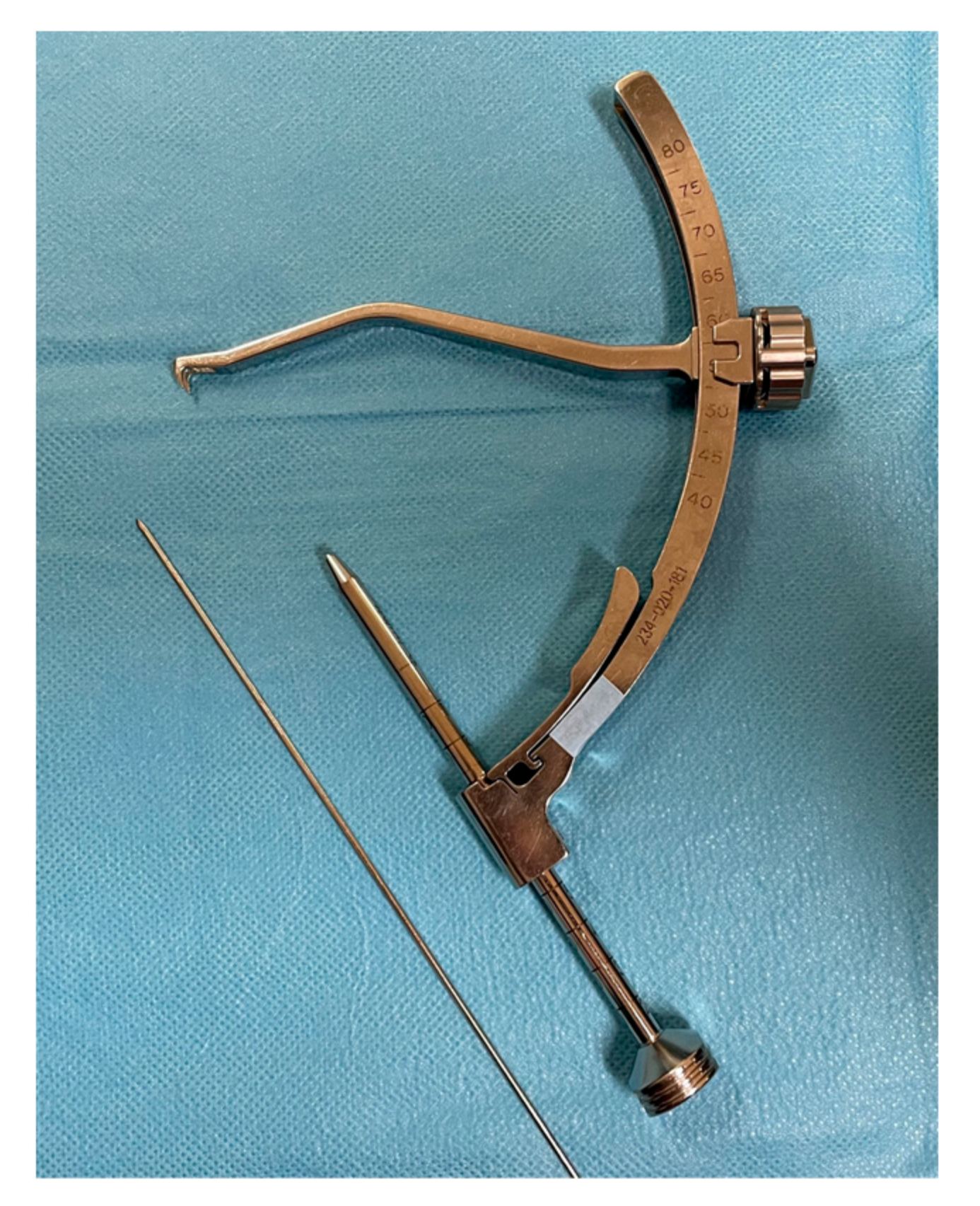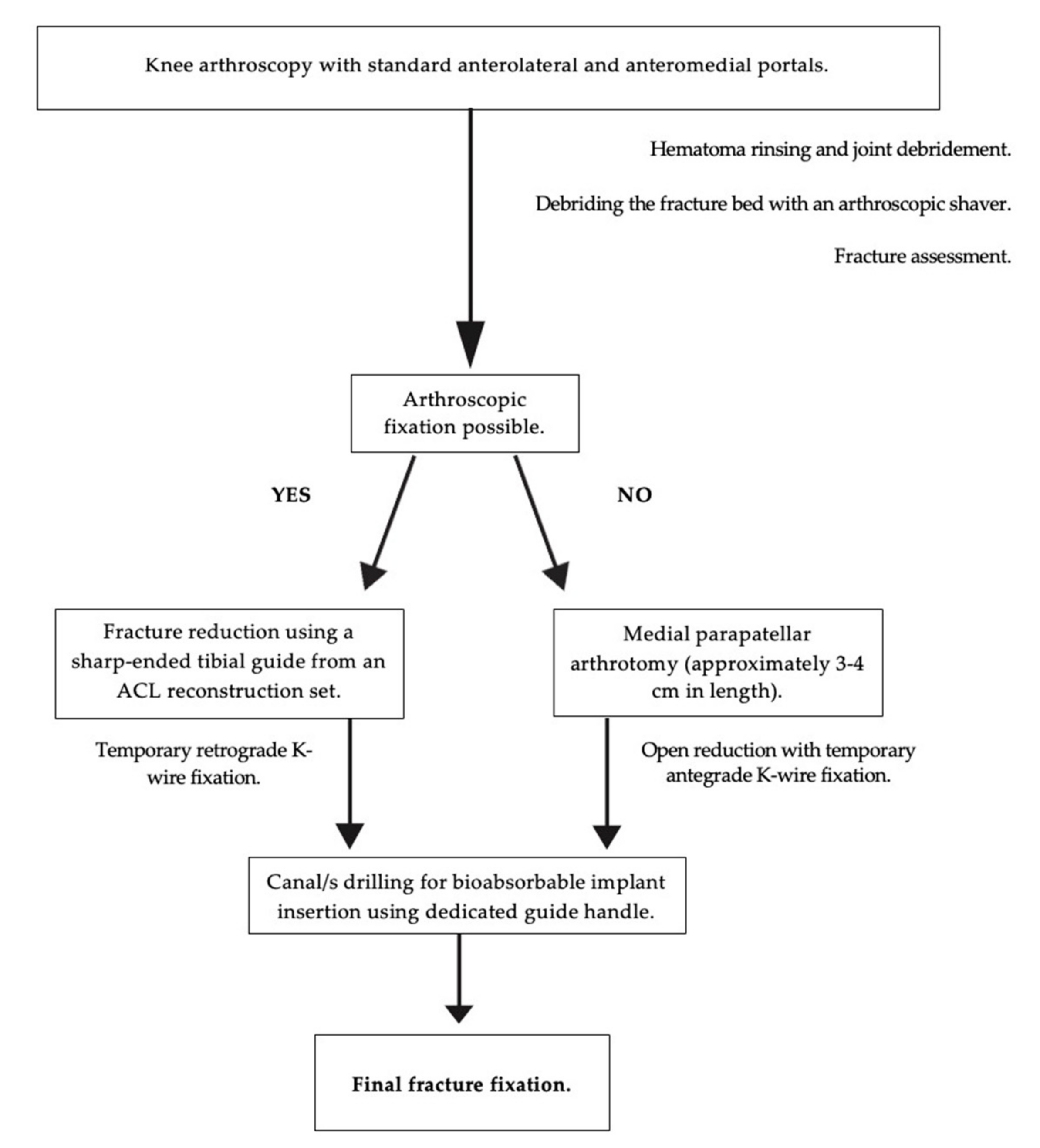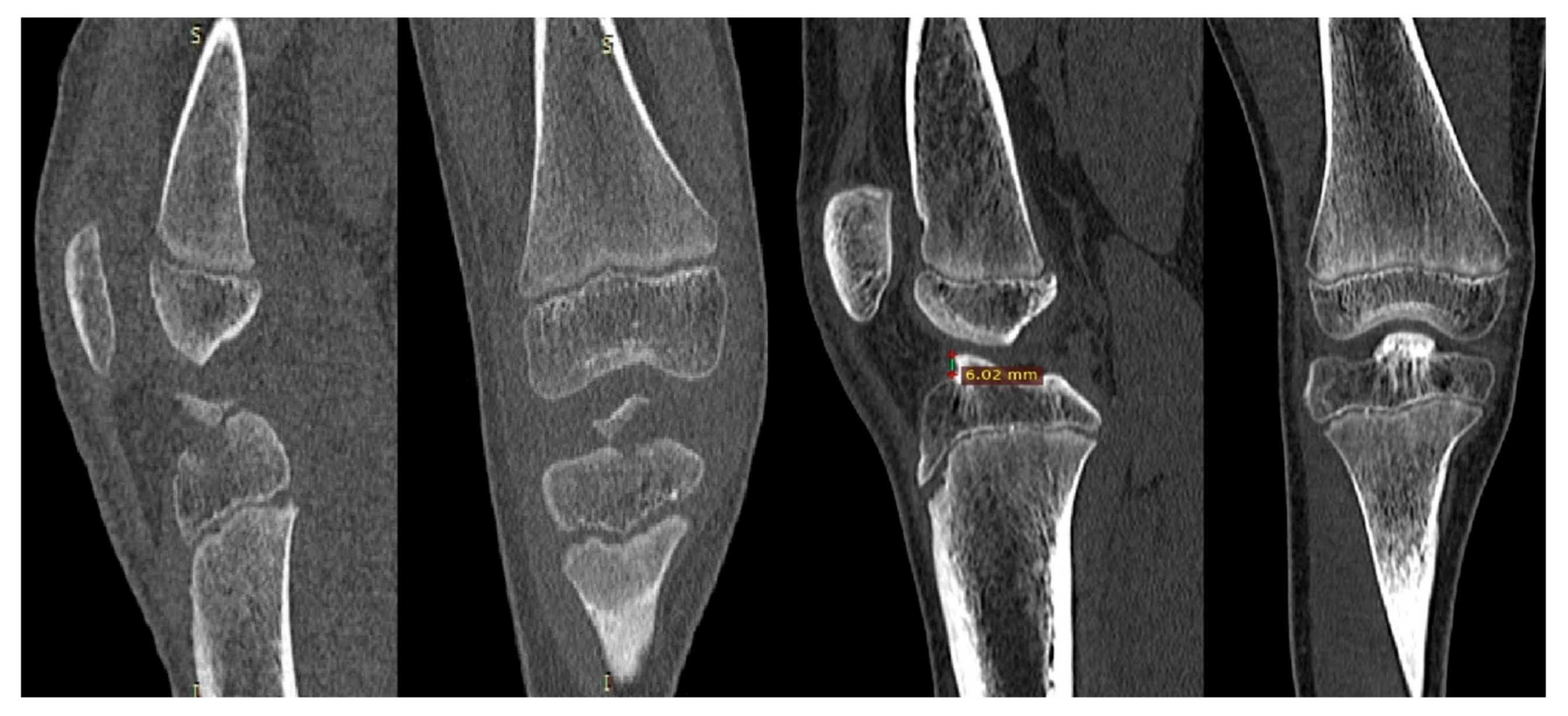Results of Anterior Cruciate Ligament Avulsion Fracture by Treatment Using Bioabsorbable Nails in Children and Adolescents
Abstract
1. Introduction
2. Materials and Methods
2.1. Surgical Technique
2.2. Clinical Follow-Up
3. Results
4. Discussion
4.1. Surgical or Non-Surgical Treatment
4.2. Surgical Treatment: Arthroscopic or Open Reduction
4.3. Surgical Treatment, Implant Selection
4.4. Complication
4.5. Study Limitations
5. Conclusions
Author Contributions
Funding
Institutional Review Board Statement
Informed Consent Statement
Data Availability Statement
Conflicts of Interest
Abbreviations
References
- Herman, M.J.; A Martinek, M.; Abzug, J.M. Complications of tibial eminence and diaphyseal fractures in children: Prevention and treatment. Instr. Course Lect. 2015, 64, 471e482. [Google Scholar] [CrossRef] [PubMed]
- Wyatt, J.D.; Treme, G.; Veitch, A.J.; Johnson, A.C. Incidence of Associated Knee Injury in Pediatric Tibial Eminence Fractures. J. Knee Surg. 2014, 27, 215–219. [Google Scholar] [CrossRef] [PubMed]
- Iborra, J.P.; Mazeau, P.; Louahem, D.; DiMéglio, A. Fractures of the intercondylar eminence of the tibia in children. Apropos of 25 cases with a 1–20 year follow up. Rev. Chir. Orthop. Repar. Appar Mot. 1999, 85, 563–573. [Google Scholar]
- Scrimshire, A.; Gawad, M.; Davies, R.; George, H. Management and outcomes of isolated paediatric tibial spine fractures. Injury 2018, 49, 437–442. [Google Scholar] [CrossRef]
- Frank, J.S.; Gambacorta, P.L. Anterior cruciate ligament injuries in the skeletally immature athlete: Diagnosis and man-agement. J. Am. Acad. Orthop. Surg. 2013, 21, 78–87. [Google Scholar] [CrossRef]
- Meyers, M.H.; Mckeever, F.M. Fracture of the intercondylar eminence of the tibia. J. Bone Joint Surg. Am. 1959, 41, 209–220. [Google Scholar] [CrossRef]
- Zaricznyj, B. Avulsion fracture of the tibial eminence: Treatment by open reduction and pinning. J. Bone Jt. Surg. 1977, 59, 1111–1114. [Google Scholar] [CrossRef]
- Jackson, T.J.; Storey, E.P.; Ganley, T.J. The surgical management of Tibial spine fractures in children: A survey of the Pediatric Orthopaedic Society of North America (POSNA). J. Pediatr. Orthop. 2019, 39, e572–e577. [Google Scholar] [CrossRef]
- LaFrance, R.M.; Giordano, B.; Goldblatt, J.; Voloshin, I.; Maloney, M. Pediatric Tibial Eminence Fractures: Evaluation and Management. J. Am. Acad. Orthop. Surg. 2010, 18, 295–405. [Google Scholar] [CrossRef]
- Perugia, D.; Basiglini, L.; Vadalà, A.; Ferretti, A. Clinical and radiological results of arthroscopically treated tibial spine fractures in childhood. Int. Orthop. 2009, 33, 243–248. [Google Scholar] [CrossRef]
- Park, H.J.; Urabe, K.; Naruse, K.; Aikawa, J.; Fujita, M.; Itoman, M. Arthroscopic evaluation after surgical repair of intercondylar eminence fractures. Arch Orthop. Trauma Surg. 2007, 127, 753–757. [Google Scholar] [CrossRef]
- Kim, Y.-M.; Kim, S.-J.; Yang, J.-Y.; Kim, K.-C. Pullout reattachment of tibial avulsion fractures of the anterior cruciate ligament: A firm, effective suture-tying method using a tensioner. Knee Surg. Sports Traumatol. Arthrosc. 2007, 15, 847–850. [Google Scholar] [CrossRef] [PubMed]
- Liljeros, K.; Werner, S.; Janarv, P.-M. Arthroscopic Fixation of Anterior Tibial Spine Fractures with Bioabsorbable Nails in Skeletally Immature Patients. Am. J. Sports Med. 2009, 37, 923–928. [Google Scholar] [CrossRef] [PubMed]
- Ahn, J.H.; Yoo, J.C. Clinical outcome of arthroscopic reduction and suture for displaced acute and chronic tibial spine fractures. Knee Surg. Sports Traumatol. Arthrosc. 2004, 13, 116–121. [Google Scholar] [CrossRef] [PubMed]
- Wouters, D.B.; De Graaf, J.S.; Hemmer, P.H.; Burgerhof, J.G.; Kramer, W.L. The arthroscopic treatment of displaced tibial spine fractures in children and adolescents using Meniscus Arrows®. Knee Surg Sports Traumatol Arthrosc. 2011, 19, 736–739. [Google Scholar] [CrossRef]
- E Hunter, R.; A Willis, J. Arthroscopic fixation of avulsion fractures of the tibial eminence: Technique and outcome. Arthrosc. J. Arthrosc. Relat. Surg. 2004, 20, 113–121. [Google Scholar] [CrossRef] [PubMed]
- von Elm, E.; Altman, D.G.; Egger, M.; Pocock, S.J.; Gøtzsche, P.C.; Vandenbroucke, J.P. The Strengthening the Reporting of Observational Studies in Epidemiology (STROBE) statement: Guidelines for reporting observational studies. Lancet 2007, 370, 1453–1457. [Google Scholar] [CrossRef] [PubMed]
- Nuzzo, M.S.; Posner, M.; Warme, W.J.; Medina, F.; Wicker, R.; Owens, B.D. Compression force and pullout strength comparison of bioabsorbable implants for osteochondral lesion fixation. Am. J. Orthop. 2011, 40, E61–E63. [Google Scholar]
- Thomas, D.M.; Stannard, J.P.; Pfeiffer, F.M.; Cook, J.L. Biomechanical Properties of Bioabsorbable Fixation for Osteochondral Shell Allografts. J. Knee Surg. 2019, 33, 365–371. [Google Scholar] [CrossRef] [PubMed]
- Lubowitz, J.H.; Bernardini, B.J.; Reid, J.B., 3rd. Current concepts review: Comprehensive physical examination for instability of the knee. Am. J. Sports Med. 2008, 36, 577–594. [Google Scholar] [CrossRef]
- Lysholm, J.; Gillquist, J. Evaluation of knee ligament surgery results with special emphasis on use of a scoring scale. Am. J. Sports Med. 1982, 10, 150–154. [Google Scholar] [CrossRef] [PubMed]
- Briggs, K.K.; Lysholm, J.; Tegner, Y.; Rodkey, W.G.; Kocher, M.S.; Steadman, J.R. The reliability, validity, and responsiveness of the Lysholm score and Tegner activity scale for anterior cruciate ligament injuries of the knee: 25 years later. Am. J. Sports Med. 2009, 37, 890–897. [Google Scholar] [CrossRef] [PubMed]
- Tegner, Y.; Lysholm, J. Rating systems in the evaluation of knee ligament injuries. Clin. Orthop. Relat. Res. 1985, 198, 43–49. [Google Scholar] [CrossRef]
- Anderson, A.F.; Federspiel, C.F.; Snyder, R.B. Evaluation of knee ligament rating systems. Am. J. Knee Surg. 1993, 6, 67–73. [Google Scholar]
- Wilfinger, C.; Castellani, C.; Raith, J.; Pilhatsch, A.; E Höllwarth, M.; Weinberg, A.-M. Nonoperative Treatment of Tibial Spine Fractures in Children-38 Patients with a Minimum Follow-up of 1 Year. J. Orthop. Trauma 2009, 23, 519–524. [Google Scholar] [CrossRef]
- Louis, M.-L.; Guillaume, J.-M.; Launay, F.; Toth, C.; Jouvre, J.-L.; Bollini, G. Surgical management of type II tibial intercondylar eminence fractures in children. J. Pediatr. Orthop. 2008, 17, 231–235. [Google Scholar] [CrossRef] [PubMed]
- Mah, J.Y.; Adili, A.; Otsuka, N.Y.; Ogilvie, R. Follow-up Study of Arthroscopic Reduction and Fixation of Type III Tibial-Eminence Fractures. J. Pediatr. Orthop. 1998, 18, 475–477. [Google Scholar] [CrossRef] [PubMed]
- Reynders, P.; Reynders, K.; Broos, P. Pediatric and Adolescent Tibial Eminence Fractures: Arthroscopic Cannulated Screw Fixation. J. Trauma Inj. Infect. Crit. Care 2002, 53, 49–54. [Google Scholar] [CrossRef]
- Grönkvist, H.; Hirsch, G.; Johansson, L. Fracture of the Anterior Tibial Spine in Children. J. Pediatr. Orthop. 1984, 4, 465–468. [Google Scholar] [CrossRef]
- Casalonga, A.; Bourelle, S.; Chalencon, F.; De Oliviera, L.; Gautheron, V.; Cottalorda, J. Tibial intercondylar eminence fractures in children: The long-term perspective. Orthop. Traumatol. Surg. Res. 2010, 96, 525–530. [Google Scholar] [CrossRef]
- Kocher, M.S.; Micheli, L.J.; Gerbino, P.; Hresko, M.T. Tibial Eminence Fractures in Children: Prevalence of Meniscal Entrapment. Am. J. Sports Med. 2003, 31, 404–407. [Google Scholar] [CrossRef] [PubMed]
- Watts, C.D.; Larson, A.N.; Milbrandt, T.A. Open Versus Arthroscopic Reduction for Tibial Eminence Fracture Fixation in Children. J. Pediatr. Orthop. 2016, 36, 437–439. [Google Scholar] [CrossRef] [PubMed]
- Furlan, D.; Pogorelic, Z.; Biocic, M.; Juric, I.; Mestrovic, J. Pediatric tibial eminence fractures: Arthroscopic treatment using K-wire. Scand. J. Surg. 2010, 99, 38–44. [Google Scholar] [CrossRef]
- Bale, R.S.; Banks, A.J. Arthroscopically guided Kirschner wire fixation for fractures of the intercondylar eminence of the tibia. J. R. Coll. Surg. Edinb. 1995, 40, 260–262. [Google Scholar]
- Hirschmann, M.T.; Mayer, R.R.; Kentsch, A.; Friederich, N.F. Physeal sparing arthroscopic fixation of displaced tibial eminence fractures: A new surgical technique. Knee Surg. Sports Traumatol. Arthrosc. 2009, 17, 741–747. [Google Scholar] [CrossRef]
- Senekovic, V.; Veselko, M. Anterograde arthroscopic fixation of avulsion fractures of the tibial eminence with a cannulated screw: Five-year results. Arthroscopy 2003, 19, 54–61. [Google Scholar] [CrossRef]
- Kocher, M.S.; Foreman, E.S.; Micheli, L.J. Laxity and functional outcome after arthroscopic reduction and internal fixation of displaced tibial spine fractures in children. Arthrosc. J. Arthrosc. Relat. Surg. 2003, 19, 1085–1090. [Google Scholar] [CrossRef]
- Sharma, A.; Lakshmanan, P.; Peehal, J.; David, H. An analysis of different types of surgical fixation for avulsion fractures of the anterior tibial spine. Acta Orthop. Belg. 2008, 74, 94–97. [Google Scholar]
- Tudisco, C.; Giovarruscio, R.; Febo, A.; Savarese, E.; Bisicchia, S. Intercondylar eminence avulsion fracture in children: Long-term follow-up of 14 cases at the end of skeletal growth. J. Pediatr. Orthop. 2010, 19, 403–408. [Google Scholar] [CrossRef]
- Zhao, J.; Huangfu, X. Arthroscopic treatment of nonunited anterior cruciate ligament tibial avulsion fracture with figure-of-8 suture fixation technique. Arthroscopy 2007, 23, 405–410. [Google Scholar] [CrossRef]
- Kogan, M.G.; Marks, P.; Amendola, A. Technique for arthroscopic suture fixation of displaced tibial intercondylar eminence fractures. Arthrosc. J. Arthrosc. Relat. Surg. 1997, 13, 301–306. [Google Scholar] [CrossRef] [PubMed]
- Patel, N.M.; Park, M.J.; Sampson, N.R.; Ganley, T.J. Tibial eminence fractures in children: Earlier posttreatment mobilization results in improved outcomes. J. Pediatr. Orthop. 2012, 32, 139–144. [Google Scholar] [CrossRef] [PubMed]
- Aderinto, J.; Walmsley, P.; Keating, J. Fractures of the tibial spine: Epidemiology and outcome. Knee 2008, 15, 164–167. [Google Scholar] [CrossRef] [PubMed]
- Shepley, R.W. Arthroscopic Treatment of Type III Tibial Spine Fractures Using Absorbable Fixation. Orthopedics 2004, 27, 767–769. [Google Scholar] [CrossRef] [PubMed]
- Smith, J.B. Knee Instability After Fractures of the Intercondylar Eminence of the Tibia. J. Pediatr. Orthop. 1984, 4, 462–464. [Google Scholar] [CrossRef]




| No. | Sex | Age | BMI | Mechanism of Injury | Meyers-McKeever Classification. Site | Time to Surgery [Day] | Surgery Type. Number of Bioabsorbable Pins | Accompanying Trauma. | Follow-Up [Month]. |
|---|---|---|---|---|---|---|---|---|---|
| 1 | Boy | 13 | 17.5 | Football match | III/L | 4 | ORIF–2× SN | 24 | |
| 2 | Girl | 5, 3 | 18.18 | Motorcycle accident | II/R | 10 | ARIF–1× SN | 102 | |
| 3 | Boy | 10, 3 | 16.5 | Football match | II/R | 13 | ORIF–2× SN | 18 | |
| 4 | Girl | 8, 5 | 17.5 | Playground slide | III/R | 5 | ORIF–2× SN | 22 | |
| 5 | Boy | 10, 8 | 16.7 | Fall from bicycle | III/L | 2 | ORIF–2× SN | 26 | |
| 6 | Girl | 5 | 14.7 | Trampoline | III/R | 1 | ARIF–2× SN | 16 | |
| 7 | Boy | 7, 9 | 21.9 | Fall from bicycle | III/L | 2 | ARIF–2× SN | 30 | |
| 8 | Boy | 12, 9 | 23.3 | Car accident | II/R | 8 | ARIF–1× SN | 24 | |
| 9 | Boy | 12, 1 | 27 | Skiing | III/L | 4 | ORIF–2× SN | 25 | |
| 10 | Girl | 7, 3 | 14.1 | Fall from ladder | IV/R | 5 | ORIF–4× SN | Partial ACL damage | 60 |
| 11 | Girl | 8, 3 | 16.1 | Skiing | III/R | 1 | ARIF–2× SN | 20 | |
| 12 | Boy | 10, 2 | 17.8 | Skiing | IV/R | 1 | ORIF–2× SN | 24 | |
| 13 | Boy | 13, 6 | 20.7 | Physical abuse | II/L | 7 | ARIF–2× SN | 25 | |
| 14 | Boy | 9, 1 | 16.7 | Fall from own height | II/L | 3 | ARIF–2× SN | 24 | |
| 15 | Boy | 12, 1 | 22.3 | Football match | III/L | 3 | ARIF–1× SN | 14 | |
| 16 | Boy | 10, 1 | 20.4 | Skiing | III/L | 7 | ARIF–2× SN | 14 | |
| 17 | Boy | 15, 2 | 20.3 | Basketball match | III/L | 1 | ARIF–2× SN | 9 |
| No. | Radiographic Union | Extension Deficit | Flexion Deficit | Lachman Test | Drawer Test | Pivot Shift Test | Lysholm Score at Follow-Up | IKDC Score at Follow-Up | Activity Level at Follow-Up |
|---|---|---|---|---|---|---|---|---|---|
| 1 | Yes | /-/ | /-/ | /-/ | 100 | 87 | Same | ||
| 2 | Malunion | 10° | /-/ | /-/ | /-/ | 95 | 83 | Lower | |
| 3 | Yes | /-/ | /-/ | /-/ | 100 | 87 | Same | ||
| 4 | Yes | /-/ | /-/ | /-/ | 100 | 87 | Same | ||
| 5 | Yes | /-/ | /-/ | /-/ | 95 | 84 | Same | ||
| 6 | Yes | /-/ | /-/ | /-/ | 100 | 87 | Same | ||
| 7 | Yes | /-/ | /-/ | /-/ | 100 | 87 | Same | ||
| 8 | Yes | /-/ | /-/ | /-/ | 100 | 87 | Same | ||
| 9 | Yes | /-/ | /-/ | /-/ | 100 | 87 | Same | ||
| 10 | Malunion | 10° | 10 | /-/ | /-/ | II° | 85 | 78 | Lower |
| 11 | Yes | /-/ | /-/ | /-/ | 100 | 87 | Same | ||
| 12 | Yes | /-/ | /-/ | /-/ | 91 | 79 | Same | ||
| 13 | Yes | /-/ | /-/ | /-/ | 91 | 81 | Same | ||
| 14 | Yes | /-/ | /-/ | /-/ | 100 | 87 | Same | ||
| 15 | Yes | 5° | /-/ | /-/ | /-/ | 95 | 81 | Lower | |
| 16 | Yes | 5° | /-/ | /-/ | /-/ | 91 | 83 | Same | |
| 17 | Yes | /-/ | /-/ | /-/ | 100 | 87 | Same |
Publisher’s Note: MDPI stays neutral with regard to jurisdictional claims in published maps and institutional affiliations. |
© 2022 by the authors. Licensee MDPI, Basel, Switzerland. This article is an open access article distributed under the terms and conditions of the Creative Commons Attribution (CC BY) license (https://creativecommons.org/licenses/by/4.0/).
Share and Cite
Wiktor, Ł.; Tomaszewski, R. Results of Anterior Cruciate Ligament Avulsion Fracture by Treatment Using Bioabsorbable Nails in Children and Adolescents. Children 2022, 9, 1897. https://doi.org/10.3390/children9121897
Wiktor Ł, Tomaszewski R. Results of Anterior Cruciate Ligament Avulsion Fracture by Treatment Using Bioabsorbable Nails in Children and Adolescents. Children. 2022; 9(12):1897. https://doi.org/10.3390/children9121897
Chicago/Turabian StyleWiktor, Łukasz, and Ryszard Tomaszewski. 2022. "Results of Anterior Cruciate Ligament Avulsion Fracture by Treatment Using Bioabsorbable Nails in Children and Adolescents" Children 9, no. 12: 1897. https://doi.org/10.3390/children9121897
APA StyleWiktor, Ł., & Tomaszewski, R. (2022). Results of Anterior Cruciate Ligament Avulsion Fracture by Treatment Using Bioabsorbable Nails in Children and Adolescents. Children, 9(12), 1897. https://doi.org/10.3390/children9121897






